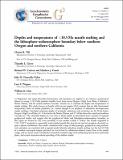Depths and temperatures of <10.5 Ma mantle melting and the lithosphere-asthenosphere boundary below southern Oregon and northern California
Author(s)
Till, Christy B.; Grove, Timothy L.; Carlson, Richard W.; Donnelly-Nolan, Julie M.; Fouch, Matthew J.; Wagner, Lara S.; Hart, William K.; ... Show more Show less
DownloadGrove_Depths and temperatures.pdf (3.460Mb)
PUBLISHER_POLICY
Publisher Policy
Article is made available in accordance with the publisher's policy and may be subject to US copyright law. Please refer to the publisher's site for terms of use.
Terms of use
Metadata
Show full item recordAbstract
Plagioclase and spinel lherzolite thermometry and barometry are applied to an extensive geochemical dataset of young (<10.5 Ma) primitive basaltic lavas from across Oregon's High Lava Plains, California's Modoc Plateau, and the central-southern Cascades volcanic arc to calculate the depths and temperatures of mantle melting. This study focuses on basalts with low pre-eruptive H2O contents that are little fractionated near-primary melts of mantle peridotite (i.e., basalts thought to be products of anhydrous decompression mantle melting). Calculated minimum depths of nominally anhydrous melt extraction are 40–58 km below Oregon's High Lava Plains, 41–51 km below the Modoc Plateau, and 37–60 km below the central and southern Cascades arc. The calculated depths are very close to Moho depths as determined from a number of regional geophysical studies and suggest that the geophysical Moho and lithosphere-asthenosphere boundary in this region are located in very close proximity to one another (within 5–10 km). The basalts originated at 1185–1383°C and point to a generally warm mantle beneath this area but not one hot enough to obviously require a plume contribution. Our results, combined with a range of other geologic, geophysical, and geochemical constraints, are consistent with a regional model whereby anhydrous mantle melting over the last 10.5 Ma in a modern convergent margin and back arc was driven by subduction-induced corner flow in the mantle wedge, and to a lesser extent, toroidal flow around the southern edge of the subducting Juan de Fuca and Gorda plates, and crustal extension-related upwelling of the shallow mantle.
Date issued
2013-04Department
Massachusetts Institute of Technology. Department of Earth, Atmospheric, and Planetary SciencesJournal
Geochemistry, Geophysics, Geosystems
Publisher
American Geophysical Union (AGU)
Citation
Till, Christy B., Timothy L. Grove, Richard W. Carlson, Julie M. Donnelly-Nolan, Matthew J. Fouch, Lara S. Wagner, and William K. Hart. “Depths and Temperatures of <10.5 Ma Mantle Melting and the Lithosphere-Asthenosphere Boundary Below Southern Oregon and Northern California.” Geochem. Geophys. Geosyst. (April 2013): 1–16. Copyright © 2013 American Geophysical Union
Version: Final published version
ISSN
15252027